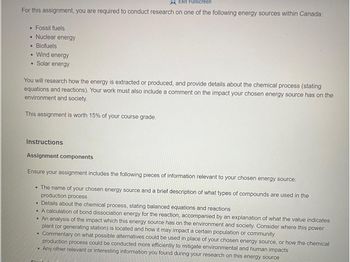
Chemistry
10th Edition
ISBN: 9781305957404
Author: Steven S. Zumdahl, Susan A. Zumdahl, Donald J. DeCoste
Publisher: Cengage Learning
expand_more
expand_more
format_list_bulleted
Question

Transcribed Image Text:Exit Fullscreen
For this assignment, you are required to conduct research on one of the following energy sources within Canada:
• Fossil fuels
• Nuclear energy
• Biofuels
• Wind energy
• Solar energy
You will research how the energy is extracted or produced, and provide details about the chemical process (stating
equations and reactions). Your work must also include a comment on the impact your chosen energy source has on the
environment and society.
This assignment is worth 15% of your course grade.
Instructions
Assignment components
Ensure your assignment includes the following pieces of information relevant to your chosen energy source:
• The name of your chosen energy source and a brief description of what types of compounds are used in the
production process
• Details about the chemical process, stating balanced equations and reactions
• A calculation of bond dissociation energy for the reaction, accompanied by an explanation of what the value indicates
• An analysis of the impact which this energy source has on the environment and society. Consider where this power
plant (or generating station) is located and how it may impact a certain population or community
Commentary on what possible alternatives could be used in place of your chosen energy source, or how the chemical
production process could be conducted more efficiently to mitigate environmental and human impacts
Any other relevant or interesting information you found during your research on this energy source
●
SAVE
AI-Generated Solution
info
AI-generated content may present inaccurate or offensive content that does not represent bartleby’s views.
Unlock instant AI solutions
Tap the button
to generate a solution
to generate a solution
Click the button to generate
a solution
a solution
Knowledge Booster
Similar questions
- 2H+ (aq) + Sn(s) → H₂ (9) + Sn²+ (aq) 2H+ (aq) + 2e → H2 (9) Ere = 0.000 V Sn2+(aq) + 2e → Sn(s) Eve = -0.140 V red Hint: Carry at least 5 significant figures during intermediate calculations to avoid round off error when taking the antilogarithm. Equilibrium constant at 298 K: AGº for this reaction would be [ than zero.arrow_forwardThe following are some of the steps in the Born-Haber cycle for Mg (s) + Br2 (l) → MgBr2(s). Check all of the reactions that you would expect to be exothermic. Mg (s) → Mg (g) Mg2+(g) + 2 Br- (g) → MgBr2 (s) Br (g) + e → Br- (g) Mg (g) → Mg+(g) + e Mg+ (g) → Mg2+(g) + earrow_forwardWhat are the strengths, weaknesses, opportunities, and threats of environmental technology, solar energy?arrow_forward
- Disadvantage of oil refineryarrow_forwardOur society is heavily reliant on fossil fuels. For example most homes in Alberta are heated by the combustion of natural gas. Energy stored in natural gas originated from: Select one: the sun intramolecular bonds oil sands plantsarrow_forwardplease answer all! thxarrow_forward
- 5. The car you have been driving has a posted fuel consumption of 10.0 L/100 km (city) and 7.1 L/100 km (highway) according to the EnerGuide information. Overall, your actual fuel consumption has averaged 10.5 L/100 km. a) Is this better or worse than the posted fuel consumption? b) Provide three reasons why your actual fuel consumption may be different from the posted consumption. c) List three ways in which you could improve your fuel consumption (other than buying a new carl).arrow_forwardonsider a cloudless day on which the sun shines down across the United States. If 2751 kJ of energy reaches a square meter m²) of the United States in one hour, how much total solar energy reaches the entire United States per hour? The entire area of the United States is 9,158,960 km². solar energy per hour: kJ/h TOOLS x10 218 PM 9/3/2021 64 F Clear ENGarrow_forwardWhen we think about the carbon cycle and human activities, it is important to differentiate between facts and hypotheses. Which of the answer choices can be considered a fact? Select all that apply. Increasing atmospheric carbon dioxide will cause mean global temperature to increase by 2 degrees Celsius over the next century. In the past, atmospheric CO₂ levels rose higher than those observed today. The burning of fossil fuels contributes substantially to the ongoing rise of atmospheric CO2- The amount of carbon dioxide in the atmosphere has increased since 1950.arrow_forward
arrow_back_ios
arrow_forward_ios
Recommended textbooks for you
 ChemistryChemistryISBN:9781305957404Author:Steven S. Zumdahl, Susan A. Zumdahl, Donald J. DeCostePublisher:Cengage Learning
ChemistryChemistryISBN:9781305957404Author:Steven S. Zumdahl, Susan A. Zumdahl, Donald J. DeCostePublisher:Cengage Learning ChemistryChemistryISBN:9781259911156Author:Raymond Chang Dr., Jason Overby ProfessorPublisher:McGraw-Hill Education
ChemistryChemistryISBN:9781259911156Author:Raymond Chang Dr., Jason Overby ProfessorPublisher:McGraw-Hill Education Principles of Instrumental AnalysisChemistryISBN:9781305577213Author:Douglas A. Skoog, F. James Holler, Stanley R. CrouchPublisher:Cengage Learning
Principles of Instrumental AnalysisChemistryISBN:9781305577213Author:Douglas A. Skoog, F. James Holler, Stanley R. CrouchPublisher:Cengage Learning Organic ChemistryChemistryISBN:9780078021558Author:Janice Gorzynski Smith Dr.Publisher:McGraw-Hill Education
Organic ChemistryChemistryISBN:9780078021558Author:Janice Gorzynski Smith Dr.Publisher:McGraw-Hill Education Chemistry: Principles and ReactionsChemistryISBN:9781305079373Author:William L. Masterton, Cecile N. HurleyPublisher:Cengage Learning
Chemistry: Principles and ReactionsChemistryISBN:9781305079373Author:William L. Masterton, Cecile N. HurleyPublisher:Cengage Learning Elementary Principles of Chemical Processes, Bind...ChemistryISBN:9781118431221Author:Richard M. Felder, Ronald W. Rousseau, Lisa G. BullardPublisher:WILEY
Elementary Principles of Chemical Processes, Bind...ChemistryISBN:9781118431221Author:Richard M. Felder, Ronald W. Rousseau, Lisa G. BullardPublisher:WILEY

Chemistry
Chemistry
ISBN:9781305957404
Author:Steven S. Zumdahl, Susan A. Zumdahl, Donald J. DeCoste
Publisher:Cengage Learning

Chemistry
Chemistry
ISBN:9781259911156
Author:Raymond Chang Dr., Jason Overby Professor
Publisher:McGraw-Hill Education

Principles of Instrumental Analysis
Chemistry
ISBN:9781305577213
Author:Douglas A. Skoog, F. James Holler, Stanley R. Crouch
Publisher:Cengage Learning

Organic Chemistry
Chemistry
ISBN:9780078021558
Author:Janice Gorzynski Smith Dr.
Publisher:McGraw-Hill Education

Chemistry: Principles and Reactions
Chemistry
ISBN:9781305079373
Author:William L. Masterton, Cecile N. Hurley
Publisher:Cengage Learning

Elementary Principles of Chemical Processes, Bind...
Chemistry
ISBN:9781118431221
Author:Richard M. Felder, Ronald W. Rousseau, Lisa G. Bullard
Publisher:WILEY